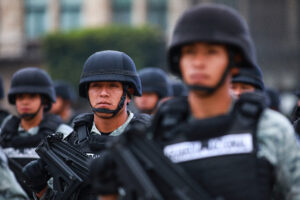Washington, DC—On January 27, four months after the disappearance of 43 students in Iguala, Guerrero, Mexico’s attorney general, Jesus Murillo Karam, stood in front of television cameras and declared that the government had concluded the investigation into the case. He presented a documentary-style video about the case, produced by the government, with grim narration, animated re-creations of the violent events of September 26-27, the night of the disappearance of students, and videotaped confessions from some of the alleged perpetrators. Rather than presenting new evidence, the attorney general reviewed existing evidence, concluding that the government was confident that the students had been killed and that its theory of the case was correct.
WOLA believes it is premature and alarming that federal authorities have announced the end of the investigation into the disappearance of student teachers. While President Peña Nieto clearly wants to put this case behind him, as it has severely injured both his domestic popularity and his international credibility, there are still many unanswered questions about the case. According to Maureen Meyer, Senior Associate for Mexico at WOLA, “declaring that the investigation of the Ayotzinapa case is over, when there are still several outstanding issues to resolve, will only reinforce the perception that the government is not committed to the rule of law.”
Following the attorney general’s announcement, the families of the students and their legal representatives held their own press conference. They categorically rejected the government’s position and listed several reasons why it is too early to end the investigation, including the lack of scientific certainty about what happened in the trash dump where the students were supposedly burned, the failure to investigate the responsibility of the Army or other authorities in Guerrero, allegations that some of the accused have been tortured, and the fact that they have identified the remains of only one of the 43 missing students. Relatives said they will continue searching for their children until they are presented with convincing evidence that they are dead.
“The weight that the government is giving to the confessions of the alleged perpetrators is concerning,” says Meyer, “especially when there are accusations that some of those arrested in the case were tortured.” In addition, the Argentine Forensic Anthropology Team (Equipo Argentino de Antropología Forense, EAAF), a group of internationally recognized experts that was hired at the request of the families, has said that there is insufficient scientific evidence to certify the government’s version of the case.
Another concern about the government’s announcement is that there has not been time for the group of independent experts, whose participation was agreed to in November 2014, by the Mexican State, the Inter-American Commission on Human Rights, and representatives of families, to carry out its work. Part of this collaboration agreement is precisely to analyze whether “all lines of inquiry have been properly exhausted” in the investigation of the students’ disappearance.
The case of the disappeared students is not isolated: the Mexican government has been unable to provide a sufficient response to the thousands of families of victims of enforced disappearances and other victims of serious human rights violations, nor has it investigated and punished the agents responsible at any level. Meyer concludes that, “Mexico is trapped in a human rights crisis of a magnitude that President Peña Nieto seems unable to grasp.”
###


